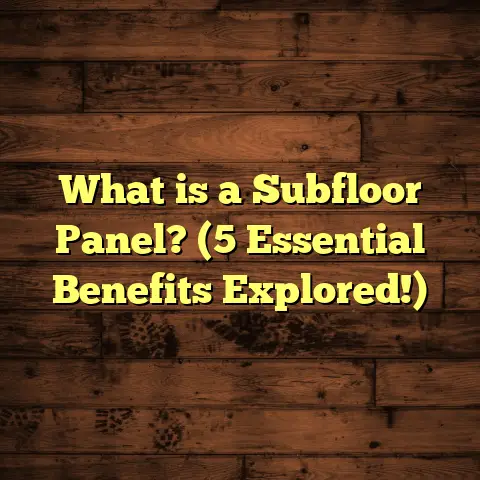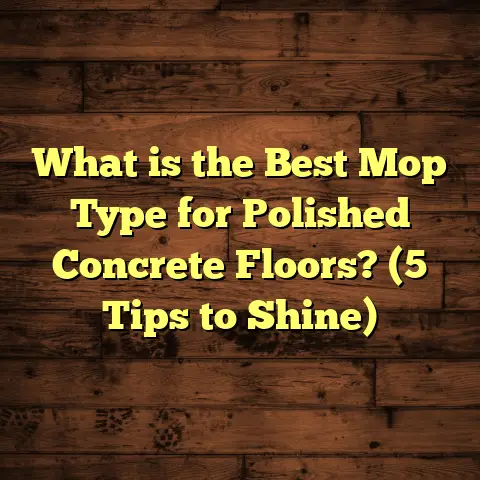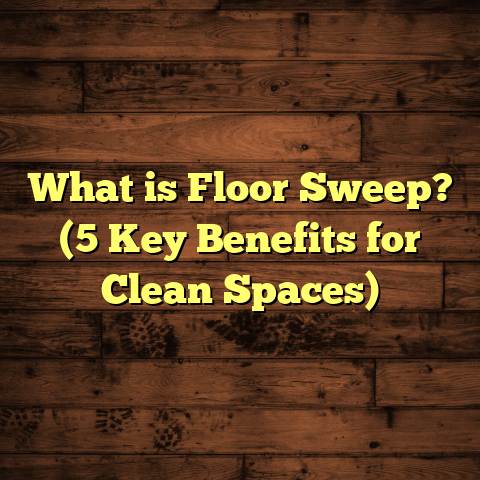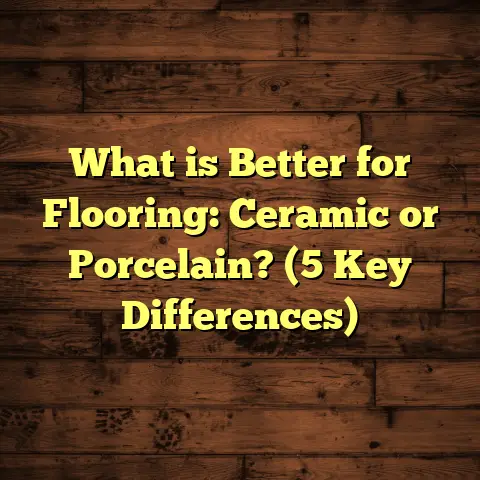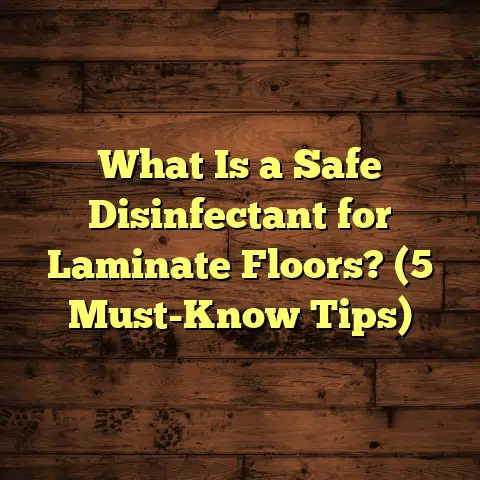What is Under Hardwood Floor? (5 Secrets Revealed!)
I’ve been working with hardwood floors for over 15 years now, and one of the questions I get asked most often is: “What’s actually under my hardwood floor?” It seems like a simple enough question, but the layers beneath your hardwood are far more complex and important than most people realize. Understanding what lies underneath can save you time, money, and headaches down the road.
I want to share everything I’ve learned about what’s under hardwood floors, from the basics to some insider secrets. I’ll also include stories from my experience, some surprising facts, and tips that can help you whether you’re installing new floors or dealing with repairs. So, pull up a chair because this is going to be a deep but easy-to-follow chat about what’s beneath the surface of your beautiful hardwood.
What Is Under Hardwood Floor?
When we talk about what’s under a hardwood floor, we’re referring to the layers that provide support, moisture protection, sound control, and insulation for the hardwood planks you walk on. These layers are critical for ensuring your hardwood floor looks good for years and performs well structurally.
Here’s a quick rundown of the main components beneath a hardwood floor:
- Floor Joists: These are the big wooden beams that support everything above them.
- Subfloor: A flat base usually made of plywood or oriented strand board (OSB) attached to the joists.
- Moisture Barrier or Vapor Retarder: Thin sheets or coatings that protect your floor from moisture coming up through concrete or crawl spaces.
- Underlayment: A cushioning layer that can provide soundproofing, minor leveling, and sometimes thermal insulation.
- Additional Layers: Sometimes you’ll find old flooring layers, adhesives, or specialty mats depending on your home’s age and construction.
Each plays a unique role. Let’s break these down one by one.
Floor Joists: The Structural Backbone
Let me start with something that often gets overlooked — the floor joists. These are large wooden beams running beneath your home’s floor. They carry the entire weight of the floors and everything on top.
Joists are usually spaced 16 or 24 inches apart on center. This spacing is important because it affects how stable your subfloor is—and in turn how solid your hardwood floor feels.
Years ago, I remember inspecting a home where the owner complained about a sagging hardwood floor. When I removed some boards, I discovered the problem wasn’t with the hardwood itself but with rotten joists that had been damaged by water leaks. The joists were soft and bowed, causing the floor above to flex and creak.
This is why it’s critical to check on joists during renovations. If they’re weakened or spaced incorrectly, no amount of fancy flooring will fix structural problems below.
Data Point: According to a 2023 report from the American Wood Council, properly spaced and maintained joists reduce floor bounce by 30–50%, making your hardwood feel more solid underfoot.
Subfloor: The Flat Foundation
Next up is the subfloor. If you think of your hardwood floor as the roof of a house, then the subfloor is like the ceiling underneath it—supporting everything and providing a level surface.
Subfloors are most often made from plywood or OSB sheets nailed or screwed directly onto the joists. Plywood tends to be stronger and more moisture-resistant than OSB, which is why many pros prefer it for hardwood floors.
In some older homes, you might find tongue-and-groove plank subfloors that have been in place for decades. While these can be solid if well-maintained, they often require leveling or replacement before installing new hardwood.
One time I worked on a 1930s bungalow where the original pine plank subfloor was uneven. We had to carefully plane down some areas and fill gaps before laying down plywood panels to provide a smooth base for the new hardwood. It was labor-intensive but necessary to prevent future squeaks and uneven wear.
Insight: A flat and sturdy subfloor reduces installation problems by up to 75%, according to industry-standard flooring installation guidelines.
Moisture Barriers: The Unsung Heroes
Hardwood floors don’t play well with moisture. Excess dampness can cause warping, cupping, or even mold growth under your flooring.
This is where moisture barriers come in. They are thin sheets (usually polyethylene plastic) or coatings placed between the subfloor (or concrete slab) and the hardwood planks. Their job is to keep moisture from seeping upward into your wood floors.
Homes built over concrete slabs or crawl spaces especially need good moisture barriers. Without them, moisture can wick up into your flooring materials causing premature damage.
I once had a project in a humid southern state where an existing hardwood floor was buckling badly after heavy rains. After pulling up the boards, we found no vapor barrier beneath the plywood subfloor. Installing a thick polyethylene sheet before reinstalling new flooring stopped the problem cold.
Statistic: Homes with proper vapor barriers under hardwood floors experience 60% fewer moisture-related flooring issues within five years compared to those without barriers (Source: National Wood Flooring Association).
Underlayment: More Than Just a Soft Layer
Underlayment is what sits directly under your hardwood planks (or sometimes engineered wood). It acts as a cushion, reducing noise and smoothing out minor subfloor imperfections.
Depending on how your hardwood is installed—whether nailed down, glued, or floating—the underlayment can be felt pads, foam sheets, cork mats, rubber padding, or even specialty soundproofing layers.
For example:
- Nail-down installations often use rosin paper or felt pads.
- Floating floors usually have foam or cork underlayment.
- Soundproofing-focused installs might add rubber mats.
In one condo renovation downtown, I helped install cork underlayment beneath engineered hardwood to reduce sound transmission between floors. The client was thrilled because it cut footstep noise dramatically without making the floor feel spongy.
Some underlayments even add thermal insulation—keeping your feet warmer in winter—something many homeowners overlook.
Additional Layers: Old Floors and Adhesives
If you live in an older home or one that has been remodeled multiple times, there may be layers of old flooring beneath your hardwood. This could include:
- Old vinyl tiles
- Linoleum sheets
- Previous generations of wood flooring
- Adhesive residues
During remodels, I’ve uncovered multiple layers stacked over each other—sometimes four or five layers thick! Removing these layers carefully is crucial before installing new hardwood; otherwise, you risk uneven surfaces or trapped moisture.
In one historic home restoration I did, we discovered old linoleum beneath the existing hardwood. Removing it exposed a solid plank subfloor that was perfect for refinishing rather than replacing—saving time and money.
Five Secrets About What’s Under Your Hardwood Floor
Now let me share some secrets I’ve learned from years in flooring work—things most homeowners don’t know about what lies beneath their hardwood floors.
Secret #1: Subfloor Material Affects Everything
Most people think plywood is standard for subfloors—but that’s not always true. OSB (oriented strand board) is common because it’s cheaper but less resistant to moisture damage.
I once installed hardwood over OSB without adding a moisture barrier in a rainy climate. After just one wet season, some areas swelled and warped. Switching to sealed plywood subflooring solved the problem immediately.
If you’re planning new floors or renovations, ask what type of subfloor you have—and consider upgrading if it’s OSB in a moisture-prone area.
Secret #2: Underlayment Can Affect How Your Floor Feels and Sounds
Underlayment isn’t just about cushioning—it impacts temperature and noise too.
Cork underlayment adds warmth because it acts as an insulator; foam underlayments offer less insulation but better leveling; rubber mats excel at soundproofing.
In one project with foam underlayment in a cold basement apartment, the client complained their feet were cold despite radiant heat below. Switching to cork solved this issue without changing the floor itself—something many never think about when choosing flooring materials.
Secret #3: Old Floors May Hide Multiple Layers
Older homes often have layers of previous flooring hidden beneath modern hardwood. These might include vinyl tiles or linoleum from past decades.
In one 1950s house I renovated, we found no less than four distinct flooring layers stacked over each other! Removing those layers took extra time but revealed solid wood planks underneath that we restored instead of replacing—saving significant costs.
If you’re buying an older home with existing hardwood floors, consider having professionals inspect beneath them first—there could be surprises lurking below.
Secret #4: Moisture Barriers Aren’t Only for Concrete Floors
Many people think vapor barriers are only needed over concrete slabs—but crawl spaces can be just as problematic if left untreated.
Homes with dirt crawl spaces often have high humidity levels that seep upward through joists and subfloors. Adding plastic sheeting over dirt floors or sealing crawl spaces drastically reduces moisture problems for hardwood floors above.
On one job site with persistent mold issues under hardwood floors, we found an unsealed crawl space beneath. After encapsulation with vapor barriers and improved ventilation, the mold stopped spreading and floor damage stopped progressing.
Secret #5: Soundproofing Starts Beneath Your Floors
If you live in multi-story buildings or apartments, soundproofing is probably more important than you realize.
Certain underlayments include rubber or cork layers designed specifically to reduce footstep noise. Without them, noise can travel through joists and subfloors into rooms below—even if your hardwood is naturally dense.
When fitting out a condo unit near a busy street last year, we installed thick rubber underlayment beneath engineered wood floors. The clients noticed a huge reduction not only in neighbors’ footsteps but also in street noise filtering through windows below their feet.
Why Knowing What’s Under Your Floor Matters
Understanding what lies beneath isn’t just interesting trivia—it has real financial and practical implications:
- Proper moisture barriers reduce repair costs related to water damage by up to 60%.
- Soundproofing underlayment can increase property value by making homes more comfortable in urban settings.
- Inspecting joists early prevents serious structural repairs later.
- Correct subfloor preparation reduces installation errors by 75%, saving time and money on callbacks.
Knowing these layers helps you make smarter decisions when installing new floors or fixing problems in existing ones.
My Personal Experience: Fixing Floors from the Ground Up
I recall one particularly frustrating project where the homeowner had installed new hardwood just six months prior but was already hearing creaks and noticing uneven boards.
After pulling up some planks, I discovered several issues:
- The subfloor was uneven OSB panels
- There was no moisture barrier over a damp basement foundation
- Joists showed signs of minor rot
Fixing these hidden problems before reinstalling hardwood made all the difference—the floor felt sturdy and quiet for years afterward.
That experience taught me never to underestimate what’s underneath your floors—it’s often where problems start before they show on top.
How To Check What’s Under Your Hardwood Floor
If you want to see for yourself what’s under your hardwood floors without ripping everything up:
- Start by removing baseboards gently; this can sometimes expose edges of underlayment or subfloor.
- Check for squeaks or soft spots—these often indicate weak joists or damaged subfloors.
- Use an inspection camera (available at hardware stores) inserted through small drilled holes to look beneath.
- Consult professional flooring contractors for detailed inspections if planning renovations.
- Testing moisture levels with a meter can reveal hidden dampness threatening your floors.
How FloorTally Can Help You Budget Your Flooring Project
One tool I recommend for anyone planning hardwood installations or repairs is FloorTally. It calculates material needs and labor costs based on local rates with options customized for different subfloors, underlayments, and moisture barriers.
This saves hours of guesswork and multiple contractor quotes by consolidating data into easy-to-understand estimates tailored to your project specifics.
Final Thoughts on What Lies Beneath Hardwood Floors
When you walk across gorgeous hardwood boards in your home, it’s easy to take those smooth surfaces at face value. But there’s so much happening underneath—from joists carrying weight to moisture barriers protecting against damage—that determines how long those floors last and how comfortable they feel.
From my years installing and repairing hardwood floors all over different climates and building types, I’ve learned that paying attention to what lies beneath is just as important as choosing beautiful wood species or finishes on top.
If you’re thinking about installing, repairing, or replacing hardwood floors anytime soon—don’t overlook what’s below. Check those hidden layers carefully; they hold more secrets than you might guess!
Additional Resources & References
- National Wood Flooring Association (NWFA) reports on flooring failures
- American Wood Council guidelines on joist spacing
- Case studies on moisture barrier effectiveness in humid climates
- Technical specs on various underlayment materials
I hope this deep look beneath hardwood floors helps you better understand what supports your beautiful surfaces every day! If you want help inspecting your current floors or planning new installations based on these insights, feel free to ask—I’m here to help!
